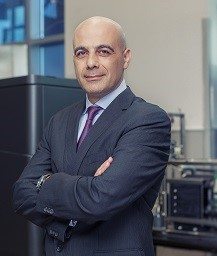GenCell CEO Rami Reshef and one of the many remote locations served by fuel cell batteries
GenCell CEO Rami Reshef feels that in a world that increasingly relies on immediacy and connectivity for social requirements and business opportunities, solving the off-grid power issue will be an important industry milestone. Reshef said fuel cells, originally pioneered by NASA for the Apollo program, can provide the 100 percent sustainable, reliable and cost-effective power needed to get rural areas online, improving lives and increasing telecom profits. GenCell’s alkaline fuel cells use a non-platinum catalyst that is fueled by industrial-grade hydrogen and oxidized with ambient air, but, Reshef stresses, with technology that is 100 percent clean (no CO₂ emissions), is cost effective and only needs refueling and maintenance once a year. The company has a global perspective with headquarters in Israel and offices in New York City and Germany as well.
Citing the fact that 14 percent of the world’s population doesn’t have electricity, telecoms or basic services, with 84 percent of those people living in rural communities, GenCell is prepared to remedy the problem by allowing telecom towers into remote areas with affordable power.
But what application does a fuel cell battery have in developed countries like the U.S? “Overall mobile coverage in the USA is very good,” Reshef told Inside Towers, “however there are still many opportunities in national parks or very rural areas that have limited or no coverage. In a well-developed country like the USA, the primary benefit of our fuel cells would be to provide backup power when the grid is lost for days or weeks due to extreme weather—especially winter storms with snow and ice that down power lines.”
With FirstNet-AT&T deployment rolling out in the U.S. to rural areas, Reshef sees it as a potentially ideal fit for their solution, in a market when you absolutely need to keep running, no matter what. “A critical system like FirstNet needs to always be available, even when the grid is down,” Reshef said. “Having a communication system that runs independently of the telecom network is only half the solution; you need it to be able to work independently of the electrical network as well. Our solution can deliver reliable, all-weather, backup power to ensure that the FirstNet system is running for days or even weeks without grid power,” he said.
The GSMA estimates that by 2020, the global telecom industry will have deployed approximately 390,000 telecom towers that are off-grid, with 790,000 towers in bad-grid locations. Most of these, more than 90 percent of them, rely on diesel powered generators. Reshef cites the resulting annual cost of diesel will be over US$ 19 billion in 2020, or US$ 5 per mobile-phone user per year, with about 45 million tons of CO₂ per year released into the atmosphere.
In remote areas with extreme weather, such as in Brazil with its high humidity, or Canada with its extreme cold, telecom providers often struggle to provide communities with a reliable and continuous telecom network. Fuel cells could bridge that gap, according to Reshef, and revolutionize telecom tower reliability, offering uninterrupted service in temperatures from -40°C up to +45°C (-40°F up to +113°F).
“In some cases, this is not a nice-to-have but a must-have technology,” he said.
By Jim Fryer, Managing Editor, Inside Towers
February 26, 2018






Reader Interactions